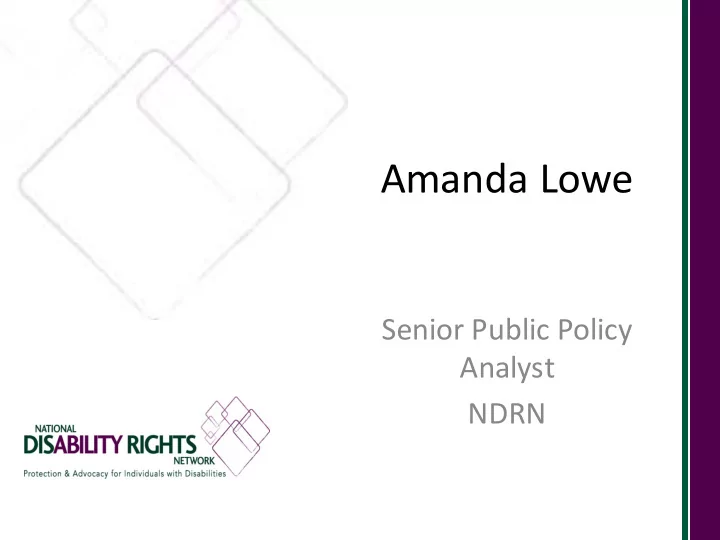

Amanda Lowe Senior Public Policy Analyst NDRN
Consortium for Citizens with Disabilities Education Task Force • The Consortium for Citizens with Disabilities (CCD) is the largest coalition of national organizations working together to advocate for federal public policy that ensures the self- determination, independence, empowerment, integration and inclusion of children and adults with disabilities in all aspects of society.
Higher Education • House –partisan debate continues -House Democrats: Aim Higher Act -Republican proposal: PROSPER Act -neither introduced yet this year • •Senate –bipartisan bill in negotiation
Higher Ed Priorities for Students with Disabilities • CCD submitted principles and recommendations: – Teacher, Early Intervention and Specialized Instructional Support Personnel (SISP) Shortages – Increasing Access – Student Loan Availability, Accessibility and Affordability. – Transition and Postsecondary Programs for Students with Intellectual Disabilities (TPSID) – http://c-c-d.org/fichiers/FINAL-CCD-HEA-Recs- 6.20.19.pdf
HEA Bills CCD ED TF Supports The Respond, Innovate, Succeed, and Empower (RISE) Act (S.1585) • - RISE Act Authorizes increased funding for a TA center that provides students • and families with information on disability services available in college and how to access them and offers college faculty training and resources on best practices to support students with disabilities. Requires colleges to accept an Individualized Education Program • (IEP), 504 plan, or prior evaluation as documentation of a student’s disability when seeking accommodations. Requires colleges to submit to the Integrated Postsecondary • Education Data System (IPEDS) or other federal data collection efforts key data related to their undergraduate students with disabilities.
HEA Bills CCD ED TF Supports Educator Preparation Reform Act (S. 969). Will expand the Teacher • Quality Partnership (TQP) grants Expanding Disability Access to Higher Education Act (S. 1176). Will • promote the matriculation, and increase in the graduation rates, of individuals with disabilities within higher education for first- generation or low-income students with disabilities including through the TRIO program. Supporting the Teaching Profession Through Revitalizing • Investments in Valuable Educators Act (STRIVE) Act. Improving Access to Higher Education Act (last Congress) •
Seclusion and Restraint No bill yet this Congress
Some Data on Seclusion and Restraint • 2009 NDRN Report, School is not Supposed to Hurt detailed cases of abuse and sometimes death due to restraint and seclusion. • 2009 GAO report found hundreds of incidents of abuse and sometimes death due to restraint and seclusion. • Education Week found that nearly 70,000 students with disabilities were restrained or secluded in a single school year. • 2018 GAO report found that restraint and seclusion used disproportionally on students with disabilities and students of color.
Keeping All Students Safe Act (KASSA) • Introduced in the 115 th Congress – Rep Beyer, (D-VA) & Sen Murphy, (D-CT) – Establish minimum safety standards – Prohibit seclusion and mechanical, chemical and physical restraint – Prohibit restraint as planned intervention – Requires parental notification and follow-up – Requires States provide training to all staff including school resource officers – Increase transparency, data collection, oversight, and enforcement to prevent future abuse and death
Physical Restraint Allowed Only When All of the Following Criteria are Met: • Student’s behavior poses imminent danger of serious physical harm . • Less restrictive interventions would be ineffective. • Physical restraint is imposed by school personnel trained and certified by State approved crisis intervention n training program. • Physical restraint ends immediately upon cessation of triggering behavior. • Physical restraint does not interfere with student’s ability to communicate in student’s primary language. • Physical restraint uses the least amount of force necessary.
IDEA Full Funding • When IDEA was first signed into law in 1975,Congress made a commitment to fund 40% of the additional cost associated with educating students under IDEA. Congress has chronically failed to keep this promise. • To date, the closest they have come to this goal through the annual appropriations process was 18% in 2005, and is under 15% in the current federal fiscal year, 2019. • The IDEA Full Funding Act gives Congress a clear ten-year glide path to realize their commitment.
IDEA Full Funding Bi partisan bills introduced House and Senate
The IDEA Full Funding Act Original Sponsors • S. 866 • Sen Van Hollen (D-MD), Sen Roberts (R-KS) • HR 1878 • Rep Huffman (D-CA), Rep McKinley (R-WV), Rep Fitzpatrick (R-PA), Rep Nequse (D-CO), Rep Katko (R-NY), Rep Schrader, (D-OR), Rep Thompson (R- PA), Rep Philips (D-MN), Rep Boyle (D-PA), Rep McNerney (D-CA), Rep Sewell (D-CA), Rep Craig (D-MN), Rep Stauber (R-MN)
Recommend
More recommend